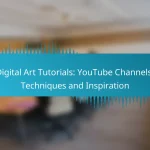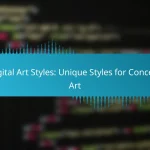AI-generated art is at the forefront of a transformative movement within the creative industry, reshaping how art is created, sold, and perceived. With increasing collaboration between artists and technologists, current trends showcase innovative expressions and enhanced accessibility. However, this evolution also brings forth complex ethical considerations regarding copyright, bias, and the authenticity of machine-created works.
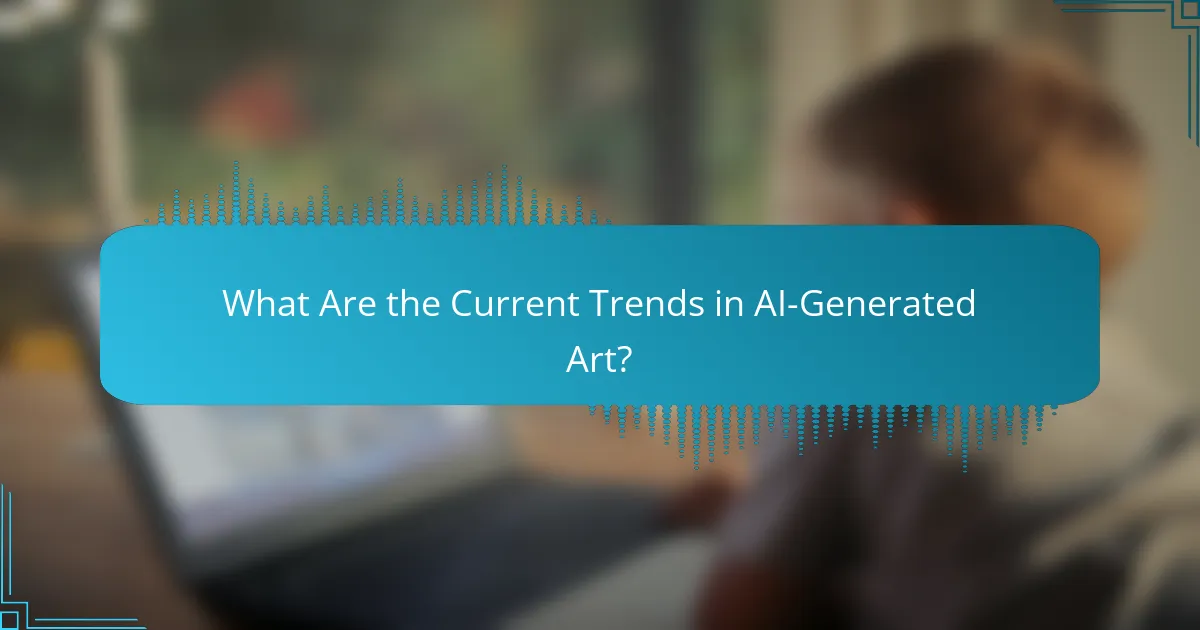
What Are the Current Trends in AI-Generated Art?
Current trends in AI-generated art highlight the growing integration of advanced technologies, platforms, and community engagement. Artists and technologists are increasingly collaborating, leading to innovative expressions and broader accessibility of AI art.
Increased Use of Generative Adversarial Networks
Generative Adversarial Networks (GANs) are becoming a cornerstone in the creation of AI-generated art. These systems consist of two neural networks, a generator and a discriminator, that work against each other to produce increasingly realistic images. This technology allows for the creation of unique artworks that can mimic various styles and genres.
Artists leveraging GANs can explore new creative avenues, producing pieces that challenge traditional notions of authorship and originality. The flexibility of GANs enables experimentation with different datasets, resulting in diverse artistic outputs.
Rise of AI Art Platforms like DALL-E
Platforms such as DALL-E have gained popularity for their ability to generate images from textual descriptions. These tools democratize art creation, allowing anyone with an idea to produce visual content without extensive artistic skills. Users can input simple phrases and receive complex images in return, showcasing the power of AI in creative processes.
As these platforms evolve, they are becoming more user-friendly and accessible, attracting a wider audience. This trend is reshaping how art is produced and consumed, with implications for both professional artists and casual creators.
Integration with Social Media for Art Sharing
Social media platforms are increasingly serving as venues for sharing AI-generated art. Artists can showcase their work on platforms like Instagram and Twitter, gaining visibility and feedback from a global audience. This integration fosters community engagement and collaboration among creators.
Moreover, the viral nature of social media allows AI art to reach diverse demographics quickly. Artists can leverage hashtags and trends to enhance their visibility, making it easier to connect with potential buyers or collaborators.
Emergence of AI Art Competitions
AI art competitions are becoming more common, providing platforms for artists to showcase their work and gain recognition. These contests often encourage innovation and experimentation, pushing the boundaries of what is possible with AI-generated art. Participants can win prizes, exposure, and opportunities for collaboration.
Such competitions also help to establish standards and benchmarks within the AI art community, promoting quality and creativity. They serve as a catalyst for dialogue about the role of AI in art and its implications for the future.
Collaboration Between Artists and AI Tools
Collaboration between artists and AI tools is a significant trend in the art world. Many artists are using AI as a partner in their creative process, combining human intuition with machine learning capabilities. This partnership can lead to unexpected and innovative outcomes that neither could achieve alone.
Artists are encouraged to experiment with various AI tools to find the right fit for their style and vision. This collaboration often results in hybrid artworks that blend traditional techniques with digital innovation, expanding the definition of art in contemporary society.
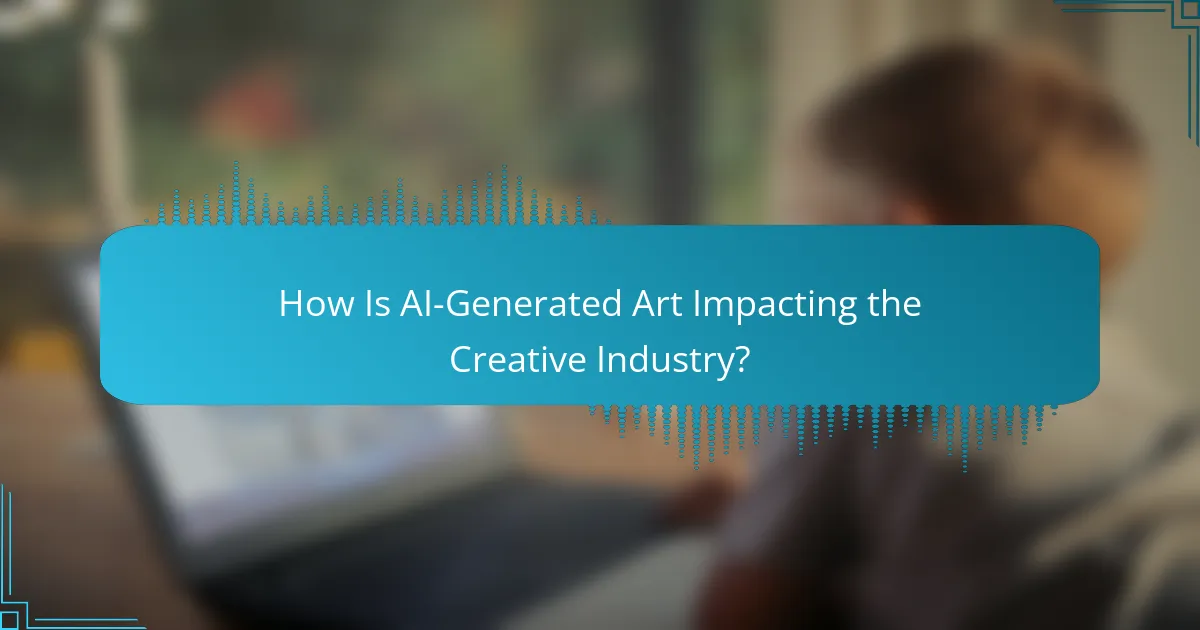
How Is AI-Generated Art Impacting the Creative Industry?
AI-generated art is significantly transforming the creative industry by altering how art is created, sold, and perceived. This technology is reshaping artistic roles, influencing market dynamics, and changing consumer attitudes toward art.
Redefining Artistic Roles and Skills
The rise of AI-generated art is redefining the roles and skills required of artists. Traditional skills in painting or sculpting are now complemented by digital literacy and an understanding of AI tools. Artists must adapt by learning to collaborate with AI systems, which can enhance their creative processes.
For instance, artists can use AI to generate initial concepts or explore variations of their work, allowing them to focus on refining and personalizing the final pieces. This shift encourages a blend of creativity and technology, fostering new artistic expressions.
Influencing Art Sales and Market Dynamics
AI-generated art is influencing art sales and market dynamics by introducing new pricing models and distribution channels. Digital platforms are increasingly showcasing AI art, making it accessible to a broader audience and allowing for lower price points compared to traditional art.
As a result, collectors are exploring diverse investment opportunities, with some AI artworks selling for thousands of dollars at auctions. This trend is prompting traditional galleries to adapt their strategies, integrating AI art into their exhibitions to attract new buyers.
Changing Consumer Perceptions of Art
Consumer perceptions of art are changing as AI-generated pieces gain popularity. Many people now view AI art as a legitimate form of creativity, challenging the notion of what constitutes “authentic” art. This shift is leading to broader acceptance of technology in the creative process.
However, there are still debates about the value of AI art compared to human-created works. Some consumers appreciate the novelty and innovation of AI-generated pieces, while others remain skeptical about the emotional depth and intent behind them.
Impact on Traditional Art Forms
The impact of AI-generated art on traditional art forms is profound, as it encourages artists to experiment with new techniques and mediums. Traditional art forms are being enriched by AI, leading to hybrid creations that blend classical styles with modern technology.
Moreover, artists are finding ways to incorporate AI tools into their workflows, enhancing their creative output. This integration can lead to the revival of interest in traditional techniques, as artists explore the interplay between human creativity and machine-generated ideas.
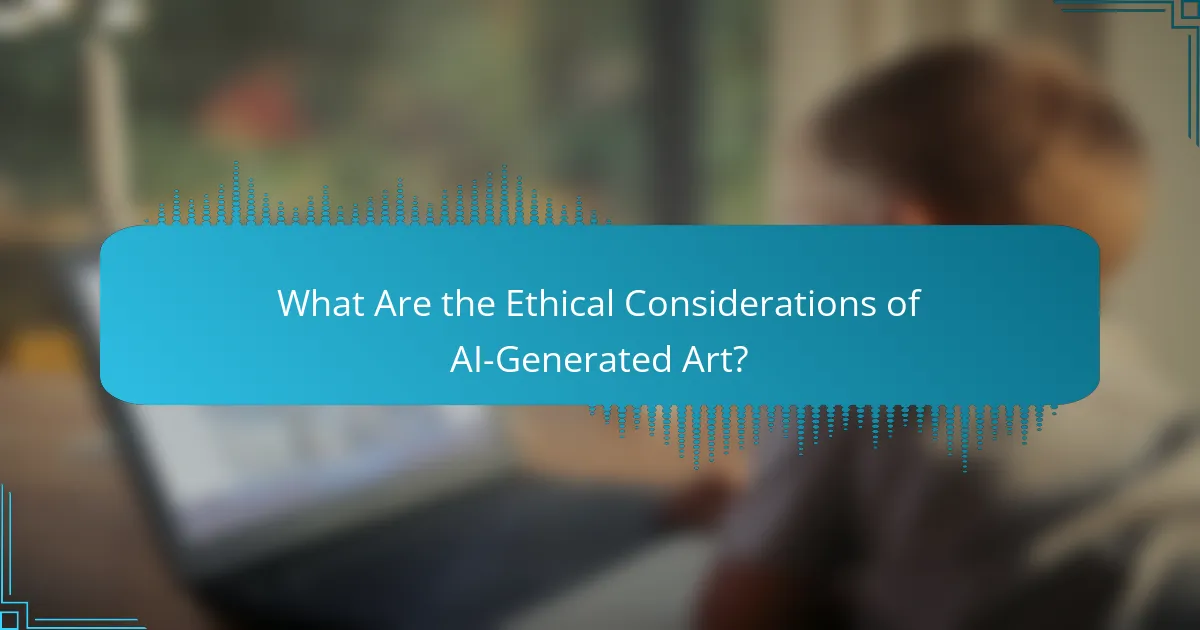
What Are the Ethical Considerations of AI-Generated Art?
The ethical considerations of AI-generated art involve complex issues surrounding copyright, bias, and the authenticity of the artwork. As AI continues to evolve, these factors raise important questions about ownership, representation, and the value of art created by machines.
Copyright and Ownership Issues
Copyright and ownership issues in AI-generated art are significant, as traditional copyright laws may not adequately address works created by algorithms. Typically, the creator of the AI or the user who inputs the parameters may claim ownership, leading to disputes over rights and profits.
For example, if an artist uses an AI tool to create a piece, questions arise about whether the artist or the AI’s developer holds the copyright. In many jurisdictions, laws are still catching up with technology, creating a gray area that artists and developers must navigate carefully.
Bias in AI Algorithms Affecting Art
Bias in AI algorithms can significantly affect the art produced, as these systems often reflect the data they are trained on. If the training data lacks diversity, the resulting artwork may perpetuate stereotypes or exclude certain cultural perspectives.
Artists and developers should be aware of the potential biases in their AI tools. Regularly auditing the training datasets and incorporating diverse inputs can help mitigate these issues and promote more inclusive artistic expressions.
Authenticity and Value of AI Art
The authenticity and value of AI-generated art are hotly debated topics. Many collectors and critics question whether art created by machines can hold the same emotional or cultural significance as human-made art.
While some argue that AI art lacks the personal touch of human creativity, others see it as a new frontier for artistic expression. As the market for AI art grows, establishing clear criteria for authenticity and value will be crucial for artists and buyers alike.
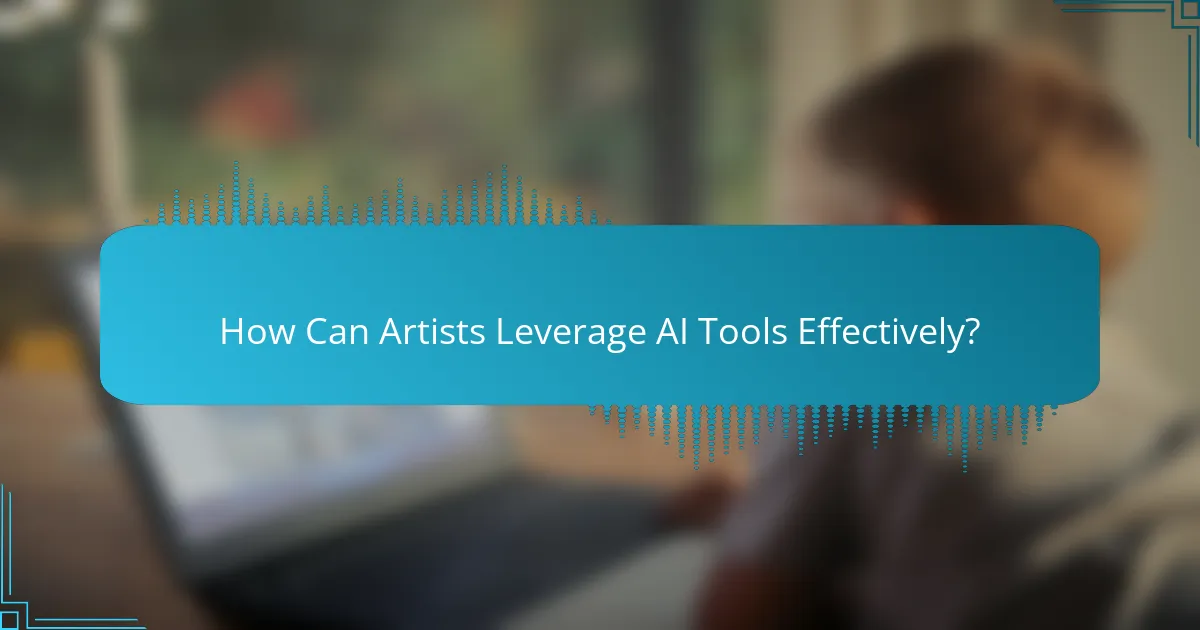
How Can Artists Leverage AI Tools Effectively?
Artists can leverage AI tools effectively by integrating them into their creative processes to enhance productivity and explore new artistic possibilities. By understanding the capabilities of various AI art software, artists can make informed choices that align with their artistic vision.
Choosing the Right AI Art Software
Selecting the right AI art software is crucial for maximizing creative potential. Consider factors such as user interface, features, and compatibility with existing tools. Popular options include DeepArt, Artbreeder, and Runway ML, each offering unique functionalities suited for different artistic styles.
Evaluate the software based on your specific needs—whether you require advanced image manipulation, style transfer, or generative art capabilities. Many platforms offer free trials, allowing artists to experiment before committing financially.
Best Practices for Integrating AI into Art Creation
To effectively integrate AI into art creation, start by defining clear goals for its use. Determine whether you want to enhance your existing work, generate new ideas, or automate repetitive tasks. This clarity will guide your approach and ensure that AI serves your artistic intent.
Maintain a balance between human creativity and AI assistance. Use AI-generated outputs as a foundation or inspiration rather than a final product. Regularly review and refine AI contributions to align them with your artistic vision, ensuring that the final work retains your personal touch.
Examples of Successful AI Art Projects
Numerous artists have successfully incorporated AI into their work, showcasing its potential. For instance, Refik Anadol’s “Archive Dreaming” uses AI to create immersive installations that visualize vast datasets, merging technology with artistic expression.
Another example is the collaboration between artist Mario Klingemann and AI algorithms, producing unique pieces that challenge traditional notions of authorship and creativity. These projects highlight how AI can expand the boundaries of art, inviting audiences to engage with new forms of creativity.
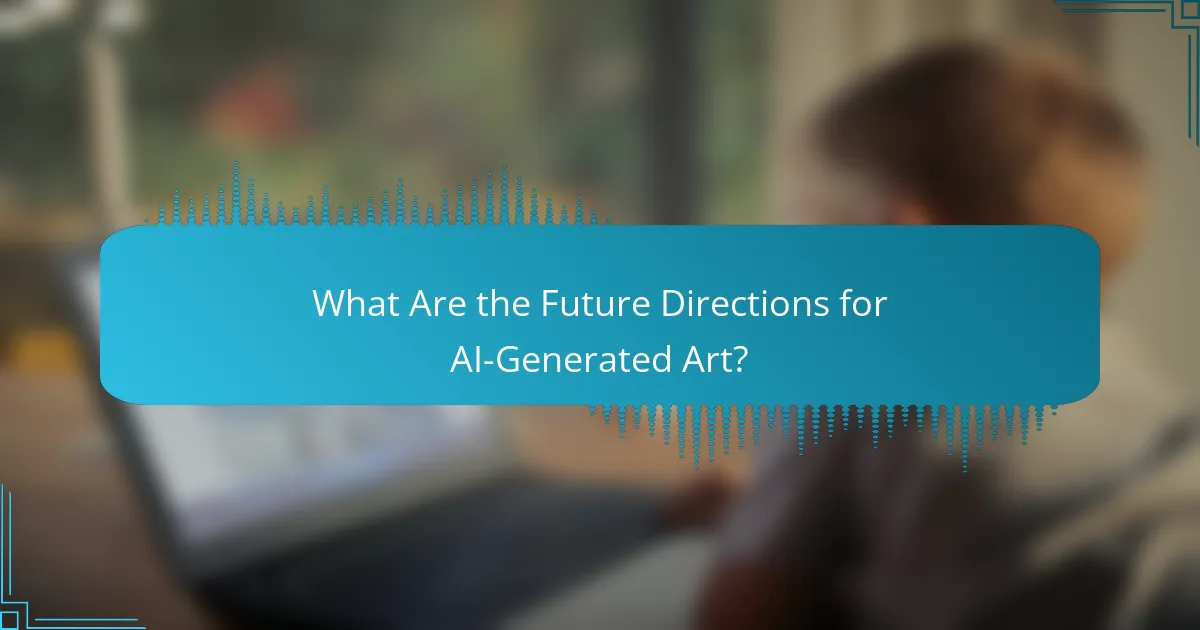
What Are the Future Directions for AI-Generated Art?
The future of AI-generated art is poised for significant evolution, driven by advancements in technology and the exploration of new artistic forms. As AI tools become more sophisticated, they will enable artists to create innovative works that challenge traditional boundaries and redefine the art experience.
Advancements in AI Technology and Techniques
AI technology is rapidly advancing, with improvements in machine learning algorithms and neural networks enhancing the capabilities of art generation. Techniques such as Generative Adversarial Networks (GANs) are becoming more refined, allowing for the creation of highly detailed and unique artworks. Artists can now leverage these tools to produce pieces that were previously unimaginable.
Moreover, the integration of real-time data and user interaction into AI art systems is becoming more common. This allows for dynamic artworks that can change based on viewer engagement or environmental factors, creating a more immersive experience.
Potential for New Art Forms and Experiences
The rise of AI-generated art opens the door to entirely new art forms and experiences. For instance, interactive installations that respond to audience input can transform passive viewing into active participation, making art more engaging. Additionally, AI can facilitate collaborations between artists and machines, leading to hybrid creations that blend human creativity with computational power.
As these technologies evolve, we may see the emergence of art that incorporates augmented reality (AR) and virtual reality (VR), allowing audiences to experience art in three-dimensional spaces. This shift could redefine how art is consumed and appreciated, making it more accessible and versatile.

